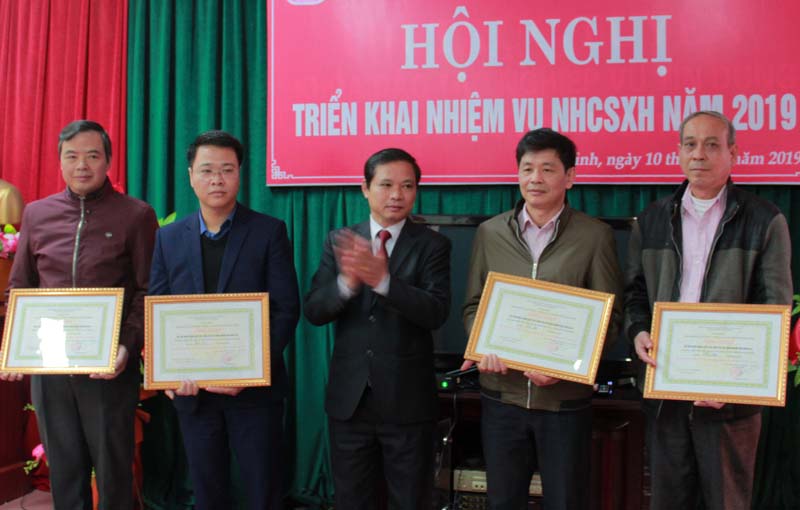
(HBO) - The Representative Committee of the Board of Directors of the Hoa Binh branch of the Vietnam Bank for Social Policies (VBSP) held a conference to review its performance in 2018 and implemented tasks for 2019. Bui Van Cuu, Vice Chairman of the provincial People's Committee, and head of the representative committee attended and directed the conference.

Leaders of VBSP’s Hoa Binh branch present
awards to four collectives with outstanding achievements in mobilising capital
in 2018.
In 2018, under the direction of the
Representative Committee of the Board of Directors, the VBSP’s Hoa Binh
branch implemented well capital mobilization and lending to poor households and
other policy beneficiaries. During the year, total lending in the whole
province reached 1.01 trillion VND, while total debt payment was 784 billion
VND.
As of December 31, 2018, total outstanding
loans under policy credit programmes were 2.93 trillion VND, reaching 99.93
percent of the plan, and increasing 227.16 billion VND year on year. There were
139,136 customers holding loans. A number of credit programmes registered high
credit growth including those designed for poor households, households living
close to poverty line and having just escaped from poverty, business households
in difficult areas, as well as programmes on clean water and rural sanitation,
housing for poor households and households from ethnic minority groups under
Decision 2085, and employment.
Overdue debts in the whole province were 4.13
billion VND, accounting for 0.14% of the total outstanding loans. As many as
119 communes, wards and towns had no overdue debt, while on-time debt payment
reached 89 percent. With the current credit policies, 99.8 percent of credit is
entrusted through four socio-political organisations.
Participants noted that the preferential
lending activities of VBSP has helped 38,700 poor households and welfare policy
beneficiaries develop their economic production and improve their living
conditions, while creating new jobs for 3,063 labourers, providing loans to 207
students with disadvantaged background to continue studying, building and
repairing 9,820 clean water supply works and 9,485 sanitation facilities in
rural areas, along with 1,054 new houses for poor households.
On this occasion, VBSP’s Hoa Binh branch
presented reward to the representative committees of VBSP’s Board of Directors
in four districts for their outstanding performance in mobilizing capital
resources. As many as 119 communal People's Committees were also awarded for
not having overdue debts in 2018./.
According to data from the Hoa Binh Provincial Party Committee, the industrial production index for the first six months of 2025 is estimated to have increased by 20% compared to the same period last year. This marks the highest year-on-year growth rate for this period since 2020.
In the first six months of 2025, Hoa Binh province’s export turnover was estimated at 1.145 billion USD, marking an 18.11% increase compared to the same period in 2024. Import turnover was estimated at $ 804 million, a 17.15% increase, which helped the province maintain a positive trade balance.
The lives of the ethnic minority farmers in Tan Lac district have gradually improved thanks to the new directions in agricultural production. This is a testament to the collective strength fostered through the professional associations and groups implemented by various levels of the district’s Farmers’ Union.
With the motto the "product quality comes first,” after nearly one year of establishment and operation, Muong village’s Clean Food Agricultural and Commercial Cooperative, located in Cau Hamlet, Hung Son Commune (Kim Boi district), has launched reputable, high-quality agricultural products to the market that are well-received by consumers. The products such as Muong village’s pork sausage, salt-cured chicken, and salt-cured pork hocks have gradually carved out a place in the market and they are on the path to obtaining the OCOP certification.
In the past, the phrase "bumper harvest, rock-bottom prices" was a familiar refrain for Vietnamese farmers engaged in fragmented, small-scale agriculture. But today, a new spirit is emerging across rural areas of Hoa Binh province - one of collaboration, organisation, and collective economic models that provide a stable foundation for production.
Maintaining growing area codes and packing facility codes in accordance with regulations is a mandatory requirement for agricultural products to be eligible for export. Recently, the Department of Agriculture and Environment of Hoa Binh province has intensified technical supervision of designated farming areas and packing facilities to safeguard the "green passport" that enables its products to access international markets.



